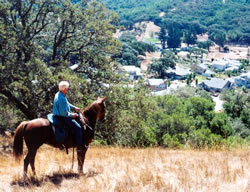“Trails and Tribulations” in the January 2005 Practical Horseman details the efforts of successful trail advocacy groups such as the Atherton Community Association (ACA) in Novato, Calif., to preserve equestrian trail access. Here, a developer with whom ACA devised creative land-use solutions offers some insider tips on how to work with, not against, land developers to everyone’s benefit.

Now a partner in Presidio Land Company, which annually builds about 1,000 new homes in California, Rich Garlinghouse was senior vice president at Southwest Diversified when that company was negotiating with ACA. He has some advice for community groups when it comes to bargaining with developers for trails and land.
- Listen. Rich says that the most important aspect to talking things out is that both sides need to listen carefully. “I can’t tell you the number of great ideas I’ve heard–and never would have thought of–by sitting down with community members. Because I was willing to listen to Craig Miller [horseman and a founder of ACA], Rush Creek became a better development,” he says. But listening is a two way street, and Rich advises advocacy leaders to “give the developer’s concerns as much respect as you want given your own.”
- Be reasonable. It’s important to appreciate that the developer has certain entitlements, for which he has paid. “You need to govern your demands based on the reality that those entitlements are sometimes not flexible,” advises Rich.
- Explain why. When requesting changes or amenities, Rich says don’t just demand; make sure you explain why this particular issue is an important one to the neighborhood. “Make it real to the developer,” he says.
- Don’t make assumptions. Both Craig and Rich say that you should not make assumptions that all developers have come to rape the lands and ruin your neighborhood. “As with anything, you should really try to come to the bargaining table with an open mind,” advises Rich, whose completion of a Chatsworth, Calif., development in 2004 resulted in 4 1/2 miles of dedicated trails with a connection to open space in the nearby Santa Monica Mountains.
- Compromise. Rich says that when developments go bad, it is often because people simply refuse to try for middle ground. “Great developments with trails and an eye towards the equestrian lifestyle always, without fail, come about because all parties were willing to compromise,” he explains. “And quite frankly, in this day and age, a willingness to make concessions and hear the other person’s point of view is really the only way to accomplish anything. This goes for developers as well as advocacy groups.”
For more on preserving trail access, read “Trails and Tribulations” in the January 2005 issue of Practical Horseman magazine.










